Superregnum: Eukaryota
Regnum: Plantae
Divisio: Tracheophyta
Divisio: Pinophyta
Classis: Pinopsida
Ordo: Pinales
Familia: Cupressaceae
Subfamilia: Cupressoideae
Genus: Cupressus
Species: C. abramsiana – C. arizonica – C. atlantica – C. austrotibetica – C. bakeri – C. benthamii – C. butanoensis – C. cashmeriana – C. chengiana – C. duclouxiana – C. dupreziana – C. fallax – C. forbesii – C. funebris – C. gansuensis – C. gigantea – C. glabra – C. goveniana – C. guadalupensis – C. lusitanica – C. macnabiana – C. macrocarpa – C. montana – C. nevadensis – C. nootkatensis – C. pygmaea – C. revealiana – C. sargentii – C. sempervirens – C. stephensonii – C. tonkinensis – C. tortulosa – C. torulosa – C. vietnamensis
Nothospecies: C. × loritiensis – C. × symbolica – C. × wangii
Source(s) of checklist:
Cupressus taxonomy, retrieved 18 Oct. 2020 A taxonomic opinion that is not peer reviewed
Name
Cupressus L., Sp. Pl. 2: 1002 (1753); Gen. Pl., ed. 5: 435 (1754).
Lectotype species: Cupressus sempervirens L., Sp. Pl. 2: 1002. (1753), designated by A.H. Kent in Veitch's Man. Conif. ed. 2: 200. 1900.
Synonyms
Heterotypic
Callitropsis Oerst., Vidensk. Meddel. Naturhist. Foren. Kjøbenhavn, ser. 2, 6: 32 (1864), nom. rej.
× Cupressocyparis Dallim., Hand-List Conif., Roy. Bot. Gard., Kew, ed. 4: 37 (1938).
× Cuprocyparis Farjon, Novon 12: 188 (2002).
Xanthocyparis Farjon & T.H.Nguyên, Novon 12: 179 (2002), nom. cons.
Platycyparis A.V.Bobrov & Melikyan, Komarovia 4: 73 (2006).
Tassilicyparis A.V.Bobrov & Melikyan, Komarovia 4: 72 (2006).
Hesperocyparis Bartel & R.A.Price, Phytologia 91: 179 (2009).
Neocupressus de Laub., Novon 19: 301 (2009), nom. superfl.
× Neocupropsis de Laub., Novon 19: 305 (2009).
× Hesperotropsis Garland & Gerry Moore, Taxon 61: 669 (2012).
Note: See discussion page with respect to the circumscription of the genus. However, read through the arguments on this website Cupressus in the Gymnosperm Database (2020) alongside Mao et al. (2019).
References
Primary references
Linnaeus, C. 1753. Species Plantarum. Tomus II: 1002. Reference page.
Linnaeus, C. 1754. Genera Plantarum, ed. 5: 435. Reference page.
Additional references
Adams, R.P., Bartel, J.A. & Price, R.A. 2009. A new genus, Hesperocyparis, for the cypresses of the Western Hemisphere (Cupressaceae). Phytologia 91(1): 160–185. PDF BHL ResearchGate Reference page.
Adams, R.P. 2018. Evolution of dioecious/monecious taxa in Juniperus, contrasted with Cupressus, Hesperocyparis, Callitropsis and Xanthocyparis (Cupressaceae). Phytologia 100(4): 248–255. Open access PDF Reference page.
Christenhusz, M.J.M., Reveal, J.L., Farjon, A., Gardner, M.F., Mill, R.R. & Chase, M.W. 2011. A new classification and linear sequence of extant gymnosperms. Phytotaxa 19: 55–70. DOI: 10.11646/phytotaxa.19.1.3 Open access Reference page.
Hutchinson, J. 1924. Contributions towards a Phylogenetic Classification of Flowering Plants: III. Bulletin of Miscellaneous Information (Royal Botanic Gardens, Kew) 1924(2): 49–66. DOI: 10.2307/4118554 Reference page.
Little, D.P. 2006. Evolution and circumscription of the true Cypresses (Cupressaceae: Cupressus). Systematic Botany 31(3): 461–480. DOI: 10.1600/036364406778388638 Paywall BioOne Paywall JSTOR Hybrid open access journal Reference page.
Mao, K., Hao, G., Liu, J.Q., Adams, R.P. & Milne, R.I. 2010. Diversification and biogeography of Juniperus (Cupressaceae): variable diversification rates and multiple intercontinental dispersals. New Phytologist 188(1): 254–272. DOI: 10.1111/j.1469-8137.2010.03351.x PDF. Reference page.
Mao, K., Ruhsam, M., Ma, Y., Graham, S.W., Liu, J.Q., Thomas, P., Milne, R.I. & Hollingsworth, P.M. 2019. A transcriptome-based resolution for a key taxonomic controversy in Cupressaceae. Annals of Botany 123(1): 153–167. DOI: 10.1093/aob/mcy152 Open access Reference page.
Terry, R.G. & Adams, R.P. 2015. A molecular re-examination of phylogenetic relationships among Juniperus, Cupressus, and the Hesperocyparis–Callitropsis–Xanthocyparis clades of Cupressaceae. Phytologia 97(1): 66–74. PDF BHL Reference page.
Xiang, Q.P. & Li, J.H. 2005. Derivation of Xanthocyparis and Juniperus from within Cupressus: Evidence from Sequences of nrDNA Internal Transcribed Spacer Region. Harvard Papers in Botany 9(2): 375–382. JSTOR Reference page.
Zhu, A., Fan, W., Adams, R.P. & Mower, J.P. 2018. Phylogenomic evidence for ancient recombination between plastid genomes of the Cupressus-Juniperus-Xanthocyparis complex (Cupressaceae). BMC Evolutionary Biology 18(137): 1–10. DOI: 10.1186/s12862-018-1258-2 Open access Reference page.
Links
Govaerts, R. et al. 2020. Cupressus in World Checklist of Selected Plant Families. The Board of Trustees of the Royal Botanic Gardens, Kew. Published online. Accessed: 2020 Jan. 18. Reference page. (accepts the segregation of Cupressus, Callitropsis, Hesperocyparis, Xanthocyparis)
International Plant Names Index. 2017. Cupressus. Published online. Accessed: Feb. 25 2017.
Tropicos.org 2017. Cupressus. Missouri Botanical Garden. Published online. Accessed: 25 Feb. 2017.
Farr, E.R. & Zijlstra, G. (eds.) 1996 onwards. Cupressus in Index Nominum Genericorum (Plantarum). Accessed: 2020 Sep 30.
IUCN link: Cupressus threatened species
Cupressus Conservation Project
USDA, ARS, Germplasm Resources Information Network. Cupressus in the Germplasm Resources Information Network (GRIN), U.S. Department of Agriculture Agricultural Research Service. Accessed: 2013-12-06.
Jarvis, C.E. (ed.) 2020. Cupressus sempervirens in the The Linnaean Plant Name Typification Project. Published on internet. Accessed 2020 Nov 08 (with update of typification).
Vernacular names
العربية: سرو
azərbaycanca: Həmişəyaşıl sərv
беларуская (тарашкевіца): Кіпарыс
беларуская: Кіпарыс
български: Кипарис
brezhoneg: Siprezenn
català: Xiprer
corsu: Cipressu
čeština: Cypřiš
чӑвашла: Кипарис
dansk: Cypres
Deutsch: Zypressen
dolnoserbski: Cypresa
Ελληνικά: Κυπαρίσσι
English: Cypress
Esperanto: Cipreso
español: Ciprés
eesti: Küpress
euskara: Altzifre
فارسی: سرو
suomi: Sypressit
français: Cyprès
Gàidhlig: Craobh-bhròin
galego: Alcipreste
עברית: ברוש
hrvatski: Čempres
hornjoserbsce: Cypresa
magyar: Ciprus
հայերեն: Նոճի
Ido: Cipreso
íslenska: Sýprus
italiano: Cipressi
日本語: イトスギ
ქართული: კვიპაროზი
한국어: 사이프러스
кыргызча: Кипарис
lingála: Sipre
lietuvių: Kiparisas
latviešu: Cipreses
македонски: Чемпрес
Nederlands: Cipres
norsk: Sypresslekten
occitan: Ciprès
polski: Cyprys
português: Cipreste
Runa Simi: Sipris
română: Chiparos
русский: Кипарис
sardu: Cipressu
srpskohrvatski / српскохрватски: Čempres
slovenčina: Cyprus
српски / srpski: Чемпрес
svenska: Cypresser
тоҷикӣ: Сарв
Türkçe: Servi
українська: Кипарис
oʻzbekcha/ўзбекча: Sarv
Tiếng Việt: Chi Hoàng đàn
West-Vlams: Cypresse
中文: 柏木属
Cupressus is one of several genera of evergreen conifers within the family Cupressaceae that have the common name cypress; for the others, see cypress. It is considered a polyphyletic group. Based on genetic and morphological analysis, the genus Cupressus is found in the subfamily Cupressoideae.[1][2] The common name "cypress" comes via the Old French cipres from the Latin cyparissus, which is the latinisation of the Greek κυπάρισσος (kypárissos).[3]
Taxonomy
There has long been significant uncertainty about the New World members of Cupressus, with several studies recovering them as forming a distinct clade from the Old World members. A 2021 molecular study found Cupressus to be the sister genus to Juniperus, whereas the western members (classified in Callitropsis and Hesperocyparis) were found to be sister to Xanthocyparis.[4]
Description
They are evergreen trees or large shrubs, growing to 5–40 m tall. The leaves are scale-like, 2–6 mm long, arranged in opposite decussate pairs, and persist for three to five years. On young plants up to two years old, the leaves are needle-like and 5–15 mm long. The cones are 8–40 mm long, globose or ovoid with four to 14 scales arranged in opposite decussate pairs; they are mature in 18–24 months from pollination. The seeds are small, 4–7 mm long, with two narrow wings, one along each side of the seed.
Many of the species are adapted to forest fires, holding their seeds for many years in closed cones until the parent trees are killed by a fire; the seeds are then released to colonise the bare, burnt ground. In other species, the cones open at maturity to release the seeds.
Distribution
As currently treated, these cypresses are native to scattered localities in mainly warm temperate regions in the Northern Hemisphere, including western North America, Central America, northwest Africa, the Middle East, the Himalayas, southern China and northern Vietnam. As with other conifers, extensive cultivation has led to a wide variety of forms, sizes and colours, that are grown in parks and gardens throughout the world.[5]
Cultivation
Many species of cypress are grown as decorative trees in parks and, in Asia, around temples; in some areas, the native distribution is hard to discern due to extensive cultivation. A few species are grown for their timber, which can be very durable. The fast-growing hybrid Leyland cypress (Cupressus × leylandii), much used in gardens, draws one of its parents from this genus (Cupressus macrocarpa, Monterey cypress); the other parent, Callitropsis nootkatensis (Nootka cypress), is also sometimes classified in this genus, or else in the separate genus Xanthocyparis, but in the past more usually in Chamaecyparis.
Cultural references
It was believed in the Hellenic culture that the cypress tree was sacred to the gods and it is now used as an emblem of grief. The name of the genus comes from Cyparissus, a young man loved by Apollo, very attached to a deer which he ended up killing by mistake during a hunting trip. To ease the pain Apollo transformed the boy into a plant. The association with mourning continued in Roman times, up to the present day, also for a practical reason: the roots of the cypress are straight into the ground, and expand slightly laterally, not damaging the burials.
Species
The number of species recognised within this genus varies sharply, from 16 to 25 or more according to the authority followed, because most populations are small and isolated, and whether they should be accorded specific, subspecific or varietal rank is difficult to ascertain. Current tendencies are to reduce the number of recognised species; when a narrow species concept is adopted, the varieties indented in the list below may also be accepted as distinct species. See also the New World species (below) for a likely split in the genus in the future.
Old World species
The Old World cypresses tend to have cones with more scales (8–14 scales, rarely 6 in C. funebris), each scale with a short broad ridge, not a spike. C. sempervirens is the type species of the genus, defining the name Cupressus. They are more closely related to Juniperus than to the New World species, with the exception of the Vietnamese golden cypress, which is more closely related to New World species.[4]
| Image | Cone | Name | Common Name | Distribution |
|---|---|---|---|---|
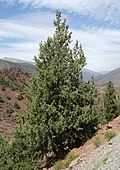 |
 |
Cupressus atlantica | Moroccan cypress | western Morocco. |
 |
 |
Cupressus cashmeriana | Bhutan cypress | eastern Himalaya in Bhutan and adjacent areas of Arunachal Pradesh in northeastern India |
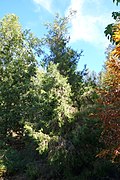 |
Cupressus chengiana | Cheng's cypress | Gansu and Sichuan Provinces, China | |
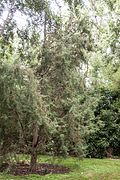 |
 |
Cupressus duclouxiana (syn: Cupressus austrotibetica)[6] | Yunnan cypress, South Tibet cypress | Yunnan and Sichuan, China |
 |
Cupressus dupreziana | Saharan cypress | southeast Algeria | |
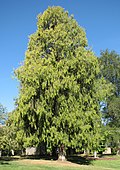 |
 |
Cupressus funebris | Chinese weeping cypress | southwestern and central China |
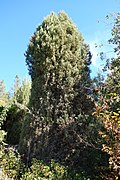 |
Cupressus gigantea | Tibetan cypress | Southeast Tibet - China | |
 |
 |
Cupressus sempervirens | Mediterranean cypress, type species | northeast Libya, southern Albania, coastal Bulgaria, southern coastal Croatia, southern Montenegro, southern Bosnia and Herzegovina, southern Greece, southern Turkey, Cyprus, northern Egypt, western Syria, Lebanon, Malta, Italy, Israel, western Jordan, and Iran |
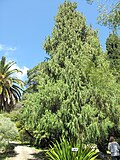 |
Cupressus torulosa (syn: Cupressus tonkinensis) | Tonkin cypress, Himalayan cypress | Sichuan of China and in Vietnam | |
 |
Cupressus vietnamensis (syn: Xanthocyparis vietnamensis) | Vietnamese cypress, Vietnamese golden cypress | Vietnam |
New World species
The New World cypresses tend to have cones with fewer scales (4-8 scales, rarely more in C. macrocarpa), each scale with an often prominent narrow spike. Recent genetic evidence[7] shows they are less closely related to the Old World cypresses than previously thought, being more closely related to Xanthocyparis than to the rest of Cupressus. These species have recently been transferred to Hesperocyparis and Callitropsis. New World species are found in marginal habitats with xeric soils, and therefore exhibit a fragmented allopatric pattern of distribution. This type of distribution results in disproportionate local abundance with most species restricted to small neighboring populations.[8]
| Image | Cone | Name | Common Name | Distribution |
|---|---|---|---|---|
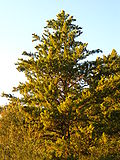 |
 |
Cupressus abramsiana (Cupressus goveniana var. abramsiana; Callitropsis abramsiana;) | Santa Cruz cypress | Santa Cruz Mountains of Santa Cruz and San Mateo Counties in west-central California |
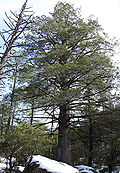 |
 |
Cupressus arizonica (Callitropsis arizonica) | Arizona cypress | southwestern United States (Arizona, Utah, southwestern New Mexico, and southern California, with a few populations in southern Nevada and in the Chisos Mountains of western Texas), and in Mexico (Coahuila, Nuevo León, Chihuahua, Sonora, Durango, Tamaulipas, Zacatecas and northern Baja California). |
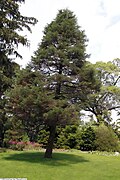 |
 |
Cupressus bakeri (Callitropsis bakeri) | Modoc cypress | northern California and extreme southwestern Oregon |
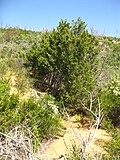 |
 |
Cupressus forbesii (Callitropsis forbesii) | Tecate cypress | Santa Ana Mountains of Orange County and in San Diego County within Southern California, and in northern Baja California state of Mexico. |
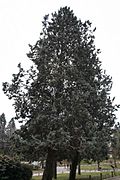 |
 |
Cupressus glabra (Callitropsis glabra) | smooth Arizona cypress | Sedona, Arizona |
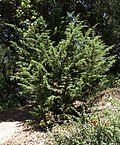 |
Cupressus goveniana (Callitropsis goveniana) | Gowen cypress, Californian cypress | Monterey County, California | |
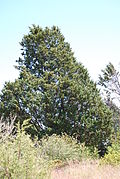 |
Cupressus guadalupensis (Callitropsis guadalupensis ) | Guadalupe cypress | Mexico, found only on Guadalupe Island | |
 |
 |
Cupressus lusitanica (Callitropsis lusitanica ) | Mexican cypress | Mexico and Central America (Guatemala, El Salvador and Honduras) |
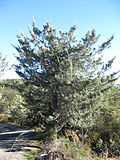 |
 |
Cupressus macnabiana (Callitropsis macnabiana ) | Macnab cypress | northern California |
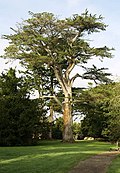 |
 |
Cupressus macrocarpa (Callitropsis macrocarpa ) | Monterey cypress | Cypress Point in Pebble Beach and at Point Lobos near Carmel, California |
| Cupressus montana (Callitropsis montana ) | San Pedro Martir cypress | Mexico: Baja California | ||
 |
 |
Cupressus nevadensis (Callitropsis nevadensis ) | Piute cypress | Southern Sierra Nevada, within Kern County, California and Tulare County. |
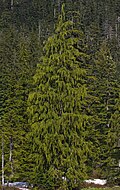 |
 |
Cupressus nootkatensis (syn: Xanthocyparis nootkatensis) | Nootka cypress | Vancouver Island, British Columbia, Canada |
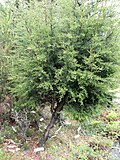 |
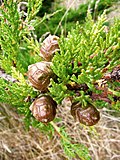 |
Cupressus pigmaea (Cupressus goveniana var. pigmaea; Callitropsis pigmaea ) | Mendocino cypress | Mendocino and Sonoma Counties in northwestern California |
 |
 |
Cupressus revealiana | El Rincon cypress | Baja California in northwestern Mexico |
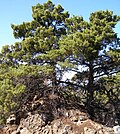 |
 |
Cupressus sargentii (Callitropsis sargentii) | Sargent cypress | Mendocino County southwards to Santa Barbara County California |
 |
 |
Cupressus stephensonii (Callitropsis stephensonii ) | Cuyamaca cypress | San Diego County California |
Allergenic potential
All plants in the genus Cupressus, including New World Cupressus (now Callitropsis), are extremely allergenic, and have an OPALS allergy scale rating of 10. In warm, Mediterranean climates, these plants release large quantities of pollen for approximately seven months each year.[9]
References
Farjon, A. (2005). Monograph of Cupressaceae and Sciadopitys. Royal Botanic Gardens, Kew. ISBN 1-84246-068-4.
Gadek, P. A., Alpers, D. L., Heslewood, M. M., & Quinn, C. J. (2000). Relationships within Cupressaceae sensu lato: a combined morphological and molecular approach. American Journal of Botany 87: 1044–1057)
κυπάρισσος, Henry George Liddell, Robert Scott, A Greek-English Lexicon, on Perseus Digital Library
Stull, Gregory W.; Qu, Xiao-Jian; Parins-Fukuchi, Caroline; Yang, Ying-Ying; Yang, Jun-Bo; Yang, Zhi-Yun; Hu, Yi; Ma, Hong; Soltis, Pamela S.; Soltis, Douglas E.; Li, De-Zhu (July 19, 2021). "Gene duplications and phylogenomic conflict underlie major pulses of phenotypic evolution in gymnosperms". Nature Plants. 7 (8): 1015–1025. doi:10.1038/s41477-021-00964-4. ISSN 2055-0278. PMID 34282286. S2CID 236141481.
Eckenwalder, James E. (2009). Conifers of the world: the complete reference. United Kingdom: Timber Press. p. 720. ISBN 978-0881929744.
"Cupressus duclouxiana in Flora of China @ efloras.org". eFloras.org Home. Retrieved 2019-08-02.
Little, D. P., Schwarzbach, A. E., Adams, R. P. & Hsieh, Chang-Fu. 2004. The circumscription and phylogenetic relationships of Callitropsis and the newly described genus Xanthocyparis (Cupressaceae). American Journal of Botany 91 (11): 1872–1881. Abstract
Little, D. P. (2006). Evolution and circumscription of the true Cypresses. Syst. Bot. 31 (3): 461-480.
Ogren, Thomas (2015). The Allergy-Fighting Garden. Berkeley, CA: Ten Speed Press. p. 95. ISBN 9781607744917.
Farjon, A. (2005). Monograph of Cupressaceae and Sciadopitys. Royal Botanic Gardens, Kew. ISBN 1-84246-068-4.
Gadek, P. A., Alpers, D. L., Heslewood, M. M., & Quinn, C. J. (2000). Relationships within Cupressaceae sensu lato: a combined morphological and molecular approach. American Journal of Botany 87: 1044–1057. Available online.
Retrieved from "http://en.wikipedia.org/"
All text is available under the terms of the GNU Free Documentation License

